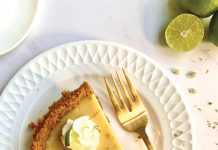
Our early ancestors kept meat and other foods preserved through sustainable techniques like building a fire to smoke game or drying fruit in the sun. During the fifteenth century, French butchers used more advanced methods of curing, including salting and heating pork in fat to make charcuterie, which translates to “cooked meat.” Today, French hams and pâtés are common fixtures on charcuterie menus, joined by salamis and sausages from Italy, Spain, and Germany, as well as other proteins.
Want to build your own charcuterie board at home? Start with three to four cured specialties in varying textures, such as creamy foie gras, sliced prosciutto di Parma, and fragrant cuts of spicy chorizo. Then add a trio of cheese wedges, some crusty bread, and garnish with olives, nuts, honey, and dried fruit.
For a cheese primer and wine pairings, we chatted with Gradon Thibeault, a fromagier and sommelier at City Cellar in West Palm Beach.

Why does picking an unknown or exotic variety of cheese feel like tiptoeing around a mousetrap? “Don’t be scared of cheeses,” says Thibeault. Originally from Maine, Thibeault gained his appreciation for milk solids while working at New York City’s now-shuttered Hotel Griffou and Casellula, a bustling cheese and wine bar in Hell’s Kitchen. Since August, he’s navigated City Cellar guests through the restaurant’s rotating selection of domestic and imported cheeses, as well as the house-cured charcuterie executive chef Kevin Darr dry ages on-site. Here, the self-described curd snob shares tips for assembling a cheese board like a pro.
MAJOR CHEESE CLASSIFICATIONS

Fresh Milk The name refers to its young age, not its freshness. These are mild cheeses with a milky flavor.
- Consistency: Soft or fluffy
- Popular varieties: Mozzarella, Chèvre, Feta
- Shelf Life: 5 to 7 days
- Pairings: French bread; caramelized nuts, sugary orange peels, lemon curd, and herbs as garnishes; Sancerre or Sauvignon Blanc from France, Vinho Verde from Portugal for wine
Washed Rind These cheeses owe their pungent odor to having been washed in a saltwater or alcoholic brine.
- Consistency: Hard to oozy
- Popular varieties: Limburger, Gruyère, Taleggio
- Shelf Life: 7 to 14 days
- Pairings: French bread; spicy sides, bourbon or whole grain mustard as garnishes; Pinot Noir from Oregon, Rioja from Spain for wine
Pressed and Cooked Hard and dry, these cheeses are typically aged for long periods of time.
- Consistency: Firm to hard
- Popular varieties: Manchego, Parmigiano-Reggiano, cheddars
- Shelf Life: 2 to 3 weeks
- Pairings: Water crackers; infused honeys and vegetable purees as garnishes; Malbec, Rosé from Provence, Cabernet or Carménére from Chile for wine
Bloomy Rind These fluffy cheeses have soft, edible rinds.
- Consistency: Semi-firm to oozy
- Popular varieties: Camembert, Brie, Humboldt Fog
- Shelf Life: 5 to 10 days
- Pairings: French bread; Marcona almonds, fruit, graham crackers, pecan brittle for garnishes; Chardonnay from California for wine
Blue Fermentation and an injection of mold powder give these cheeses their namesake blue veins.
- Consistency: Soft to crumbly
- Popular varieties: Roquefort, Gorgonzola, Stilton
- Shelf Life: 5 to 10 days if soft, 2 to 3 weeks if dry
- Pairings: Nutella, anything chocolate, bacon-bourbon jam, candied star fruit for garnishes; Bordeaux, Port, Madeira for wine
CHEESE TIPS
 Fridge, Don’t Freeze: Store cheese in the refrigerator, not the freezer, as freezing adversely affects its texture and flavor. Opt for the lowest part of the fridge, where it’s warmer and more humid.
Fridge, Don’t Freeze: Store cheese in the refrigerator, not the freezer, as freezing adversely affects its texture and flavor. Opt for the lowest part of the fridge, where it’s warmer and more humid.
Face Off: Remove mold by cutting off a thin layer with the edge of a knife, a process known as “facing.”
Breathe In: Skip the plastic and store cheese in a breathable paper, like parchment.
Soft Serve: Let cheese sit at room temperature for 30 to 40 minutes. It’ll taste better and be easier to cut.
Sniff Test: Camel cheese is one variety Thibeault can’t stomach. “It tastes like a dirty diaper,” he says.










Facebook Comments